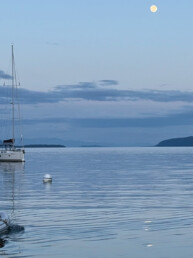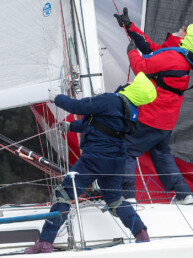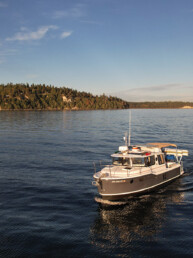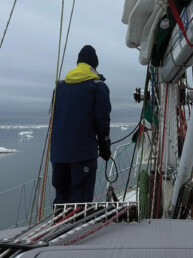From the April issue of 48° North.
Not just a mark on a race course or an obstruction to keep clear of, Blakely Rock has a life of its own at low tide.
With the possibility the pandemic might keep the U.S./Canada border closed into another summer, Puget Sound boaters may be once again looking for destinations closer to home. One of my favorites is Blakely Rock, only six miles from our Shilshole homeport. At high tide, it’s just a rock about 15 feet above water, a danger to be avoided and a useful turning point for racing sailors. At low tide, it’s a small island with a breathtaking view of the Seattle skyline, a white shell beach for landing, and fascinating sea creatures. The U.S. Coast Pilot Volume 10 describes it as 300 yards long with shoal water extending over 250 yards north. It’s one of the best places in Puget Sound to see rocky-shore sea life and is worth visiting any time there’s an extreme low tide.
My husband, Steve, and I discovered Blakely Rock’s attractions by accident years ago. We had anchored Osprey, our Annapolis 44 sloop, for the night at nearby Blakely Harbor and woke to a minus 3 foot tide. From our cabin windows, we saw a series of seaweed-covered rock ridges stretching north from Blakely Rock. Our first reaction was, “Wow! That looks dangerous!” We shuddered, thinking of the many times we had sailed close to the rock, not realizing what was below us. We were also curious. What would we find there? We got in our dinghy and motored out to the white shell beach. We pulled the dinghy up the sloping beach, set the anchor into the sand and started exploring. Within a few steps, we were wading in a large tide pool with small crabs and bullheads darting in front of us.
I’ve always loved exploring low-tide beaches. As a child, I would walk miles on the sandy beach of Three Tree Point near our house, pulling moon snails and cockles out of the sand and turning over sea stars and sand dollars. But as I grew older, I discovered that rocky ocean shores had more interesting sea life than sandy beaches on Puget Sound. I would beg my parents to drive us to Makah Bay (near Cape Flattery) to see the colorful tide pools.
Now, I found myself, years later, astonished to see animals and plants that resembled ocean creatures on Blakely Rock, just a few miles from my childhood home. Red algae grew on low-lying rocks, masses of purple and orange sea stars crammed themselves into rock crevasses, and bright red sea anemones lurked under overhanging seaweed. Barnacles large enough to host their own barnacles grew everywhere. I could have spent the whole day poking among seaweeds and rocks, but the tide was coming in, giving us only a few hours on the beach.
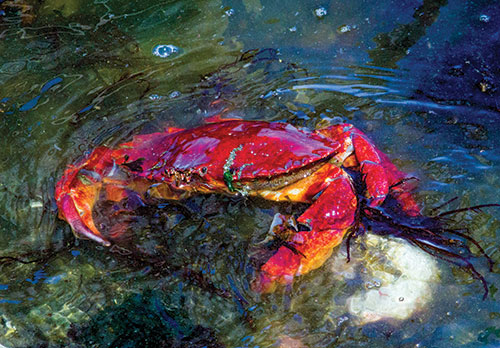
Why does Blakely Rock support this amazing community of sea life? Thinking back to the oceanography classes I took at the University of Washington, I recalled that rocks provide adequate surfaces for creatures to cling to and currents can bring a steady supply of food. The fact that few people find their way out there to disturb the ecosystem could also help. (Although the landing beach is popular with kayakers and owners of other small boats, most who land there stay on the white shell beach.)
One June morning we arrived off Blakely Rock to see two cruising-style powerboats sitting catawampus on newly exposed rocks. They must have struck the rock when it was just below the surface. They had inadvertently discovered the best time to visit Blakely Rock: spring or early summer when the lowest low tides usually happen in the morning or early afternoon.
After several trips to Blakely Rock, we learned that the most interesting sea life becomes visible at a low tide of at least minus 2 feet; the lower the better.
Anchoring off Blakely Rock
 Marked with a light and a red and white beacon, Blakely Rock is located only one mile east of the protected anchorage of Blakely Harbor. From that anchorage, it’s possible to row, paddle, or motor to the landing beach with a sturdy dinghy or kayak. Boaters can also anchor off the rock itself, paying close attention to weather and the set of their anchor. The seaweed-covered bottom drops off steeply, but it’s possible to find anchorage in about 7 fathoms off the shell beach, avoiding the submerged rocks to the north of the shell beach. In north winds, the most protected anchorage is close to the south side of the rock in deeper water. You may have to compete with sport fishermen for the best spots.
Marked with a light and a red and white beacon, Blakely Rock is located only one mile east of the protected anchorage of Blakely Harbor. From that anchorage, it’s possible to row, paddle, or motor to the landing beach with a sturdy dinghy or kayak. Boaters can also anchor off the rock itself, paying close attention to weather and the set of their anchor. The seaweed-covered bottom drops off steeply, but it’s possible to find anchorage in about 7 fathoms off the shell beach, avoiding the submerged rocks to the north of the shell beach. In north winds, the most protected anchorage is close to the south side of the rock in deeper water. You may have to compete with sport fishermen for the best spots.
Land your dinghy on the white shell beach on the west side of the rock and walk east. You’ll first wade through several large tidepools where fish dart among pebbles and crabs scuttle across the bottom. As you continue east, walking from a high tide beach to a low tide beach, green seaweed gives way to brown algae, then to red. I like to head for the low tide beach first to make sure I see it before the tide comes in. I know that, by looking underneath fronds of red algae, I’ll find a treasure trove of sea creatures.
Climbing over seaweed-covered rocks can be slippery and dangerous. I wear boots rather than sandals because they give better purchase and protect both the sides and soles of the feet.
During many visits to Blakely Rock, we have been thrilled to see different sea animals almost every year. We’ve seen: clingfish — a stocky little brown fish with a suction cup on its underside; helmet crabs — long-legged orange crabs with spines; red rock crabs; translucent sea slugs; red and brown striped sea anemones; patches of bright pink coralline algae; a big glob of tiny magenta eggs — possibly fish eggs; and many other creatures.
Starting in 2014, the Rock was a good spot to see the effects of a sea borne pandemic: the sea star wasting disease, which caused starfish to turn to goo and lose their limbs. Scientists recently determined that the wasting disease was caused by a bloom of nutrient-loving bacteria draining oxygen from the water, suffocating the sea stars.
In 2012 we saw both purple sea stars and sunflower stars healthy and plentiful, although the wasting disease was already prevalent elsewhere in Puget Sound. By 2014, every sea star we saw was disintegrating. But by 2018, healthy purple sea stars were back, although less plentiful than in 2012. Multi-armed sunflower stars had not returned at that time, and have now been designated critically endangered; but small red blood stars once again added spots of color to the rocks. We may see future cycles of starfish suffocation due to climate change, but in 2020 we were happy to see healthy sea stars on the Rock. Blakely Rock will be a good spot to see future changes.
In 2020, we saw a new aspect of the rock: boaters enjoying a trip there for the first time. I had suggested adding Blakely Rock to the Puget Sound Cruising Club’s July 4th get-together at Blakely Harbor and members took me up on it. The morning of the 4th, a crowd of boaters pulled their dinghies and kayaks onto the shell beach and fanned out across the seaweed-covered rocks. Splashing through tidepools, they watched sea slugs and crabs swim, lifted up seaweed to look for crabs, then thrilled at the sight of a seal pup sunning himself atop a rock. Finally, they stood on the beach and looked out across the sound at the Space Needle in the distance. Few who visited the rock that day had been there before. They will be back. As will I.
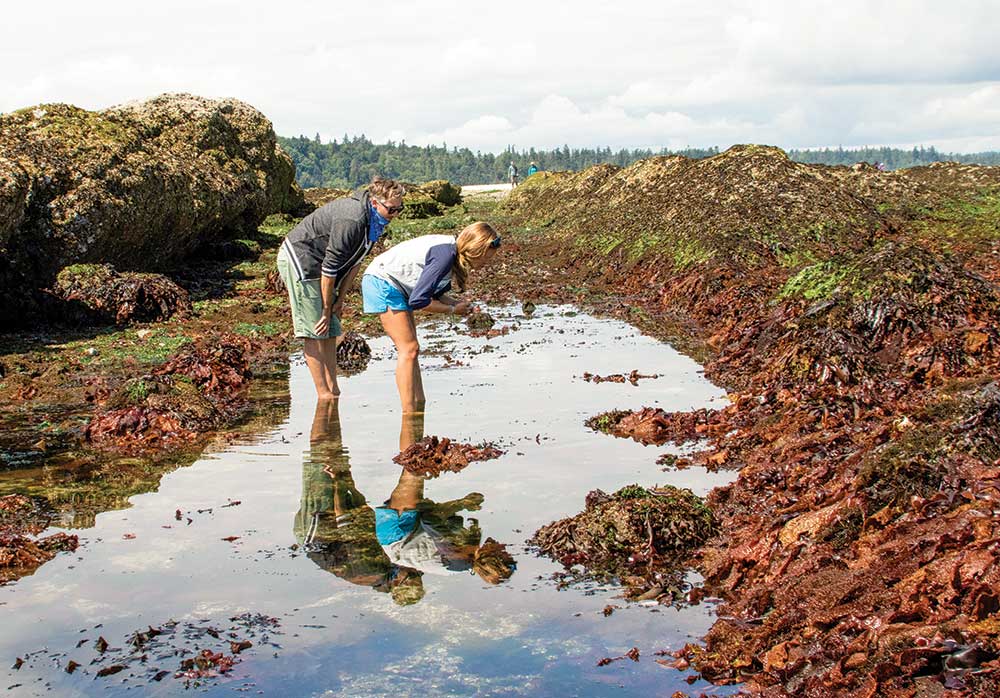 To learn more about the sea creatures living on Blakely Rock, consult these books:
To learn more about the sea creatures living on Blakely Rock, consult these books:
Whelks to Whales: Coastal Marine Life of the Pacific Northwest. Rick M. Harbo. Harbour Publishing. 2011. Paperback 328 pages. (A very portable and useful guide.)
Marine Life of the Pacific Northwest: A Photographic Encyclopedia of Invertebrates, Seaweeds and Selected Fishes. Andy Lamb and Bernard P. Lamb. Harbour Publishing. 2005. Hardback. 398 pages. (Beautiful photographs in a coffee-table format.)
Between Pacific Tides. 5th edition. Edward F. Ricketts and Jack Calvin. Stanford University Press. 1985. (A highly readable and informative classic. Ed Ricketts was the basis for the character of Doc of John Steinbeck’s Cannery Row.)
Some bacteria are suffocating sea stars, turning the animals into goo. Erin Garcia de Jesus. Science News. January 20, 2021. www.sciencenews.org/?s=starfish+wasting+disease
Sunflower sea stars declared critically endangered on West Coast. Monica Samayoa (OPB) Dec. 11, 2020.
www.opb.org/article/2020/12/11/sunflower-sea-stars-critically-endangered-species/

